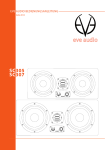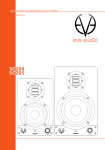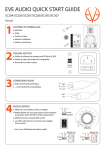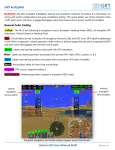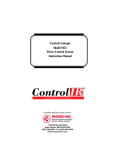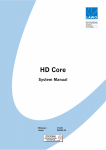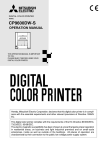Download Eve Audio TS108 Product manual
Transcript
EVE AUDIO PRODUCT MANUAL AUG 2013 TS107 TS108 TS110 TS112 TS107 TS108 TS110 TS112 EVE Audio product manual SAFETY INSTRUCTIONS TABLE OF CONTENT To avoid the risk of electrical shock, do not attempt to open the unit. There are no user-serviceable parts inside. Do not attempt to service the equipment yourself. In case of problems, please contact your local dealer or distributor. 1.INTRODUCTION.............................................................................4 ! This unit should be connected to a grounded power outlet. If you use extension cords and power distributors they should be grounded as well. ! Verify that the specified operating voltage on the rear side matches the local mains voltage. If these values do not match you will have to adjust the loudspeaker setting appropriately and change the fuse type. Use only the fuse types specified on the rear side of the unit. Never bypass the fuse. Make sure that no liquids wet the inside of the cabinet. Never spray, pour or spill liquids directly onto the unit. Do not use a wet cloth nor flammable or acid chemicals for cleaning. ! ! Do not touch the diaphragms of the loudspeaker. ! Do not expose this product to extreme temperatures. Make sure there is enough air flow behind the loudspeaker to maintain the electronic components cool. The diaphragms build up a magnetic field around the loudspeaker. High sound pressure levels can damage your hearing permanently! Avoid standing close to loudspeakers producing high sound pressure levels. 2. QUICK START..................................................................................5 2.1. 2.2. 2.3. First Steps..............................................................................................................................5 Subwoofer Connection....................................................................................................5 Powering On........................................................................................................................5 3.OPERATION....................................................................................6 3.1. First Steps..............................................................................................................................6 3.2. Operating Modes...............................................................................................................7 3.3. Powering on/off: Standby Mode..................................................................................7 3.4. Volume Mode......................................................................................................................7 3.5. Settings Menu.....................................................................................................................9 3.6.Filter........................................................................................................................................9 3.7. Sat. Filter................................................................................................................................9 3.8. Sub Filter............................................................................................................................ 10 3.9. Sub Phase........................................................................................................................... 10 3.10. LED Mode........................................................................................................................... 10 3.11. Saving Your Settings...................................................................................................... 11 3.12. Remote Control................................................................................................................ 11 3.13. Power Switch.................................................................................................................... 12 3.14. DIP Switches...................................................................................................................... 12 3.15. Mains Voltage Selector.................................................................................................. 13 3.16. Power Connector (IEC).................................................................................................. 13 4.POSITIONING...............................................................................14 4.1. 4.2. 4.3. 4.4. 4.5. Subwoofer Positioning.................................................................................................. 14 Height and Distance...................................................................................................... 14 Stereo Setup + Subwoofer (2.1)................................................................................. 15 Multichannel Setup (5.1).............................................................................................. 16 Room Acoustics............................................................................................................... 17 5. TECHNICAL SPECIFICATIONS......................................................18 6.COMPLIANCE................................................................................19 7.WARRANTY...................................................................................20 2 3 TS107 TS108 TS110 TS112 EVE Audio product manual 1. INTRODUCTION 2. QUICK START Thank you for your time and interest in the EVE Audio product range. EVE Audio is a loudspeaker manufacturer based in Berlin, Germany, that specializes in the development and design of unique studio monitors. The use of first-class components is our highest priority because we firmly believe this is the only way to manufacture first-class products. You have chosen a subwoofer from our ThunderStorm series. All four models — TS107, TS108, TS110 and TS112 — make use of passive radiators instead of a bass reflex port. This allows for a lower tuning of the subwoofer and avoids the emergence of hum, which is unavoidable when applying the bass reflex port design. The passive radiator is on the bottom side of the subwoofer. The subwoofers of the ThunderStorm series are the ideal extension for the two, three and four-way systems of the EVE Audio lverCone series. They can be easily integrated in any situation thanks to their ThunderStorm Chassis (6,5”, 8”, 10” and 12”), PWM amplifiers (100, 150, 250 and 400 Watt), accurate DSP technology and IR remote control. We wish you a lot of fun with your EVE Audio subwoofer. If you have any questions regarding our products, do not hesitate to contact your nearest dealer or get directly in touch with us... We will be more than happy to help you out! All the best from Berlin. The EVE Audio Team 4 INTRODUCTION If you already have experience with studio subwoofers, the Quick Start guide ought to be more than enough to get you started. For unexperienced users we recommend reading the whole user’s manual in order to prevent any misuse. 2.1. First Steps Check the package components (loudspeaker, remote control + batteries, user’s manual, power cord). Check the voltage setting (see “Mains Voltage Selector”). Check the setting of the DIP Switches (variable). 2.2. Subwoofer Connection Connect the two inputs on the rear side (L In + R In) to the left and right XLR outputs of a playback source, for instance, an audio interface. The output level should be as low as possible. Connect the two outputs on the rear side (L Out + R Out) to the corresponding XLR inputs of your studio’s left and right satellites. All output levels should be as low as possible. 2.3. Powering On Engage the Power switch on the rear side of the subwoofer to turn it on or off. The LEDs around the System Volume control on the front panel will light up clockwise. If the LED on the right end is dimly lit, this indicates that the subwoofer is in Standby mode. Press the System Volume control to turn the subwoofer on. If you turn the System Volume control counter clockwise until the LED on the left end lights up dimly the subwoofer will be muted. Increase the output level on the source device until the LED ring starts to blink, then reduce the output level a bit. The maximum operating level for the input (i.e. the analog to digital converter) is now set optimally. To set the desired listening volume use the System Volume control on the subwoofer. The LED ring indicates the volume setting. If the LED ring starts to blink, reduce the output level on the signal source. QUICK START Powering On 5 TS107 TS108 TS110 TS112 EVE Audio product manual 3. OPERATION 3.2. Operating Modes 3.1. First Steps Standby mode | Volume mode (-10 dB) | Settings menu (Sub Filter @ 100 Hz) 3.3. Powering on/off: Standby Mode Press and hold the System Volume control three seconds in order to put the subwoofer in Standby mode. The total volume (subwoofer + satellites) will decrease gradually while the LED ring lights up once around the System Volume control. Afterwards, the LED on the right end will remain dimly lit and the power consumption is reduced to 1 watt. !! To exit the Standby mode press briefly the System Volume control once again. The level will increase gradually until it reaches the previously selected volume. Rear Connections & DIP Switches •• •• 6 Check the package components (loudspeaker, remote control + batteries, user’s manual, power cord). Check the voltage setting (see “Mains Voltage Selector”). Check the setting of the DIP Switches (variable). Connections: there are XLR input and output connectors on the rear side that allow the connection of balanced and unbalanced devices (signal sources, active monitors, etc.). Balanced XLR pin assignment XLR: 1 = Shield, 2 = hot (+), 3 = cold(-). Unbalanced XLR pin assignment XLR: 1+3 = Shield, 2 = Signal. Depending on the setting of the Max. Input DIP switch on the rear panel, the maximum level of the source signal should not exceed +7 dBu or +22 dBu (see Max. Input). If the input is overloaded the LED ring will start blinking. OPERATION First Steps 3.4. Volume Mode •• Level Adjustment The maximum input level for balanced and unbalanced signals is +7 dBu or +22 dBu, depending on the position of the Max. Input switch on the rear panel (see DIP Switches). Higher levels at the input produce distortion due to the overloading of the analog to digital converter. Given that some professional studio devices can produce in excess of +22 dBu, the LED ring will start blinking whenever the AD converter is overloading. Generally speaking, the +7dBu setting ought to be suitable. If that is the case, the output level of the source should be reduced. •• •• Total Volume Adjustment Turn the System Volume control to adjust the total volume (subwoofer + satellites). Depending on the LED mode selected (see LED mode), the volume will be displayed as a dim/bright circle or as a dim/bright point. Subwoofer Volume Adjustment Turn the Subwoofer Volume control to adjust the volume of the subwoofer independently from the satellites. This allows you to strike the right balance between subwoofer and satellites. The LED ring indicates the volume setting. OPERATION Volume Mode 7 TS107 TS108 TS110 TS112 EVE Audio product manual 3.5. Settings Menu -20 dB 1 Step = 0.5 dB (1 LED = 4 Steps) 1 Step = 1 dB (1 LED = 4 Steps) -12 dB 1 Step = 0.5 dB (1 LED = 2 Steps) Additional status LEDs on the front panel plus infrared sensor -8 dB -48 dB 1 Step = 2 dB (1 LED = 4 Steps) 1 Step = 0.5 dB (1 LED = 4 Steps) 0 dB -80 dB Both controls feature the exact same response curve, which is not linear. The increments become finer as the volume increases: -80 dB (minimum) to -48 dB: 2 dB -48 dB to -20 dB: 1 dB -20 dB to 0 dB (maximum): 0.5 dB •• !! •• !! 8 Subwoofer Mute To Mute the subwoofer, press briefly the Subwoofer Volume control. All LEDs will turn off, except for the left-most LED, which lights up dimly. To exit the Subwoofer Mute mode press the Subwoofer Volume control once again. The subwoofer will return to the volume level it had before being muted. System Mute To Mute the whole system (subwoofer + satellites), turn the System Volume control counter clockwise until you reach the minimum level. When the LED on the left end of the System Volume control lights up dimly the Mute mode is activated. To exit the System Mute mode simply turn the System Volume control clockwise until you reach the desired volume. OPERATION Volume Mode !! Press the System Volume control once to enter the Settings menu. Here you can set two different filters (Sat. Filter and Sub Filter), as well as the phase of the subwoofer and the behavior of the volume controls’ LED rings. The LED of the currently active function will blink. Turn the System Volume control to choose the filter, phase or LED mode desired. The blinking LED indicates the function selected, while the steadyon LED indicates the value assigned to that function. Press the System Volume control to confirm your selection. The blinking will stop once the selection is confirmed. Turn the System Volume control to adjust the filter, phase or LED behavior. When you are satisfied with the setting press the System Volume control again to go back to the Settings menu. You can then select and edit another function. To exit the Settings menu press and hold the System Volume control for three seconds or simply wait 10 seconds. The subwoofer will then return automatically to the Volume mode. 3.6. Filter The filters of the EVE Audio subwoofer were specially developed to offer you the possibility of adjusting your subwoofer to the characteristics of your system. These filters help control the overlapping of frequencies between the subwoofer and the satellites. The goal is to optimize the sound image to the room acoustics and to a given listening distance. 3.7. Sat. Filter The Sat. Filter is a high-pass filter that can be used to filter out all content below 80 Hz from the L + R outputs going to the satellite speakers. Use this OPERATION Sat. Filter 9 TS107 TS108 TS110 TS112 EVE Audio product manual filter to avoid the overlapping of frequencies between the subwoofer and the satellites and to clean up the sound image in the lower end. Generally speaking, the Sat. Filter should be engaged (default setting). If inactive, for example, when the satellite speakers cannot reproduce the frequency range below 80 Hz, the Sat Flat LED lights on and the audio signal is not filtered. 3.8. Sub Filter The Sub Filter is a low-pass filter that allows you to set the upper frequency limit of the subwoofer. It can be set from 60 Hz up to 140 Hz. We recommend setting it at 80Hz, but do bear in mind that it might need to be adjusted depending on the room and satellite speakers used. In LFE mode the cutoff frequency is set to 300Hz. The LFE LED indicates when this filter is activated. 3.9. Sub Phase This setting allows you to shift 180° the phase of the subwoofer signal. The Sub Phase LED lights on. Use this function when the overall sound (subwoofer + satellites) sounds a bit thin. This can happen if the subwoofer’s phase is offset from the satellites’ due to time differences. •• Dimly Lit Point Only the LEDs corresponding to the selected volume level light up dimly. The louder the signal, the further up the dimly lit-up point moves. !! Intermediate steps are indicated by the lighting of two adjacent LEDs. The level ranges from -60 dB to +10 dB, taking “0 dB” as reference point. 3.11. Saving Your Settings All settings on the front and rear panels are automatically saved. The loudspeakers can be disconnected anytime without the settings being lost. 3.12. Remote Control Your EVE Audio subwoofer comes with an IR remote control that allows you to control almost all functions available on the front panel. In order to start using the remote control, you must first insert the supplied batteries in the battery compartment. Please pay attention to the polarity. Hold the remote control in such a way that the infrared cell points towards the receiver cell on the subwoofer. There should be no objects between both cells in order to achieve the best performance. 3.10. LED Mode The LED mode determines in which of the four available fashions the LED rings display the volume level. The LEDs represent given levels, which are displayed and adjusted according to four or two steps. Intermediate steps are indicated by the brightness between two adjacent LEDs. 10 •• Bright Ring All LEDs up to the selected volume level light up brightly. The louder the signal, the longer the brightly lit-up ring. •• On Button Use the On button to put the subwoofer in Standby mode (see Powering On/off: Standy Mode). Press the button again to exit the Standby mode. •• Bright Point Only the LEDs corresponding to the selected volume level light up brightly. The louder the signal, the further up the brightly lit-up point moves. •• •• Dimly Lit Ring All LEDs up to the selected volume level light up dimly. The louder the signal, the longer the dimly lit-up ring. In this mode, the LEDs light up brightly momentarily while you adjust the volume level. LED Button Use the LED button to select the LED mode of the subwoofer. The mode changes every time you press the button (bright ring, bright point, dimly lit ring, dimly lit point). •• Phase Button Press the Phase button to shift 180° the phase of the subwoofer signal (see Sub Phase). The Sub Phase LED on the subwoofer lights on. Press the OPERATION LED Mode OPERATION Remote Control 11 TS107 TS108 TS110 TS112 EVE Audio product manual button again to return the phase to 0°. •• Pure Satellite Button Use the Pure Satellite button to mute the subwoofer (Mute function: see Subwoofer Mute) so that the audio signal is transmitted without any filtering to the satellite speakers. This allows you to switch easily between satellites + subwoofer mode and pure satellite mode (without subwoofer and without any filtering). •• System Volume (+)/(-) Buttons Use the System Volume (+) and (-) buttons to increase or decrease the total volume (subwoofer + satellites). •• Sub Volume (+)/(-) Buttons Use the Sub Volume (+) and (-) buttons to increase or decrease the subwoofer volume, and thus balance the level between subwoofer + satellites (see Subwoofer Volume Adjustment). •• Sub Filter (+)/(-) Buttons Use the Sub Filter (+) and (-) buttons to set the cutoff frequency of the subwoofer’s low-pass filter and to select the LFE mode (see Sub Filter). •• Mute Button Press the Mute button to mute the whole system (subwoofer + satellites) (see System Mute). Press the button again to exit the Mute mode. 3.13. Power Switch The power switch on the rear panel disconnects the subwoofer completely from the power grid. When powered off all settings are saved and the power consumption is reduced to 0 watts. After powering on again, the subwoofer will return to the state it was in before being turned off (Standby mode, Mute mode or a given volume level). Even if powered off via a multiple outlet power strip, the subwoofer will return to the state it was in before being turned off. !! In order to prevent switching noise with your monitoring system, keep in mind the following rules: Power all audio sources on first, then the subwoofer and then the satellites. When turning off your system, power off the satellites first, then the subwoofer and finally all audio sources. 3.14. DIP Switches On the rear panel of your EVE Audio subwoofers you will find four DIP 12 OPERATION DIP Switches Switches. These allow you to secure your subwoofer settings to prevent them from being changed inadvertently. •• Filter When set to “lock,” this DIP Switch secures the current filter settings. The filter settings can be read on the LED ring of the System Volume control on the front panel, but they cannot be modified. When set to “var,” the filters can be modified freely. •• Volume When set to “lock,” this DIP Switch secures the current volume settings. The LED rings on the front panel indicate the volume settings of the subwoofer and the satellites, but they cannot be modified. When set to “var,” the volume setting can be changed by simply turning the knob. •• Not used No Function. •• Max. Input This DIP Switch determines the input sensitivity of the subwoofer. In a studio environment, the maximum level (0dB) ought to be 4dBu. In such environments, leave the setting at “+7dBu.” However, some studio gear allow much higher output levels. If it were impossible to reduce the output level of such devices, set the switch to “+22dBu.” The “+7dBu” setting ought to be suitable for most situations. 3.15. Mains Voltage Selector The Mains Voltage Selector allows you to adjust the operating voltage of your EVE Audio subwoofer to the local power grid. Set it to “230” if your local power grid is 220-240 volts or “115” if it is 110-120 volts. If you change the mains voltage value you also have to replace the fuse of the IEC connector with an appropriate one. The corresponding fuse values are printed on the unit underneath the IEC connector. 3.16. Power Connector (IEC) Use the power cord supplied to connect your EVE Audio subwoofer to the power grid. The IEC connector includes an integrated fuse. If your EVE Audio loudspeaker stops working and the fuse seems to be the problem, proceed as follows: •• Turn the subwoofer off. •• Disconnect it from the power grid. •• Detach the IEC connector from the unit. OPERATION Power Connector (IEC) 13 TS107 TS108 TS110 TS112 •• •• EVE Audio product manual Remove the fuse. Change the fuse. The replacement fuse should comply with the values stated on the subwoofer. 4. POSITIONING 4.1. Subwoofer Positioning Ideally, there should be no objects or obstacles between the subwoofer and the listening position. We recommend to keep a distance of at least 0.5 m (19 inches) to the walls, in order to avoid low frequency boosting. larger. 4.3. Stereo Setup + Subwoofer (2.1) In such a setup, the subwoofer is fed by the stereo signal source. The subwoofer filters the low frequency components of the stereo channels and sums them to produce a mono signal, which it then reproduces. The high frequencies are forwarded to the full-range satellite speakers. 4.2. Height and Distance Your EVE Audio subwoofer should be placed on the floor. The surface where it stands ought to be as firm and stable as possible, in order to prevent surface vibrations from generating unwanted resonances. The distance from subwoofer to listening spot depends on the position of the satellites. Ideally, the subwoofer and satellites should be at the same distance from the listener. In a 2.1 system the subwoofer ought to be placed between both satellites (see Stereo Setup + Subwoofer). In a 5.1 system the subwoofer ought to be placed between the two front satellites (see Multichannel Setup). Room area in m² (sq ft) Room volume in m³ (cu ft) Recommended subwoofer Recommended Satellites: 2.1 Setup Recommended Satellites: 5.1 Setup up to 15 (161) up to 40 (1412) TS107 SC204, SC205 SC204 15 to 20 (162 to 215) 40 to 50 (1412 to 1766) TS108 SC205, SC207, SC305 SC204, SC205 20 to 25 (215 to 269) 50 to 70 (1766 to 2472) TS110 SC207, SC208, SC205, SC207, SC307, SC407, SC208, SC305 SC408 TS112 SC205, SC207, SC208, SC307, SC208, SC305, SC407, SC408 SC307, SC407, SC408 25 to 30 (269 to 323) !! 14 70 to 90 (2472 to 3178) These values are only meant as a reference and depend a lot on the characteristics of the room. In live rooms you will be forced to reduce the distance, while in dead rooms the distance to the loudspeakers can be POSITIONING Height and Distance 60° •• •• •• Refer to the table above to determine the best 2.1 setup for your room. The so-called “stereo triangle” is the best way to place the satellites in a stereo setup, i.e. the monitors and the listening position should form an equilateral triangle. Try the following: Establish the ideal distance to the listening position. Place the monitors in such a way that the distance from each other and to the listening position is the same. Turn both monitors so that their front panels are pointed towards the listening position (all angles of the stereo triangle should be 60º). The subwoofer should be placed on the ground between both satellites. Considering that low frequencies are omnidirectional, the subwoofer does not have to be centered exactly between the two satellites. The subwoofer POSITIONING Stereo Setup + Subwoofer (2.1) 15 TS107 TS108 TS110 TS112 EVE Audio product manual can be moved back a bit so that it is at the same distance from the listening position as the satellites. This guarantees all transducers are aligned in time. 4.4. Multichannel Setup (5.1) The most common 5.1 systems consist of three front channels (left, right and center), two surround channels (left/right) and a subwoofer for the low frequencies. The speakers form a circle around the listening position. 60° 80° 140° position forming an angle of 140º. Verify that all speakers are at the same distance from the listening position, so that they are aligned in time. 4.5. Room Acoustics In order for the described measures to work effectively, we recommend that you put special attention to the room acoustics. The size, contents, wall parallelism, proportion, and reflective behavior of the room, as well as the corners, the building materials and their characteristics play a very important role in the acoustics of a room. Room acoustics is a science in itself and it is unfortunately out of the scope of this manual. However, we have put together a short bibliography for you: •• “Recording Studio Design” by Philip Newell. ISBN: 0-240-51917-5 •• “Home Recording Studio – Build it like the Pros” by Rod Gervais. ISBN: 1-59863-034-2 •• “Studio Akustik“ (in German) by Andreas Friesecke. ISBN: 978-3-932275-81-4 •• “Praktische Raumakustik” (in German) by Thomas Hentschel. ISBN 978-38364-6800-8 •• “Handbuch der Tonstudiotechnik” Book 1 (in German) by Michael Dickreiter. ISBN 3-598-11321-8 •• “Handbuch der Audiotechnik” (in German) by Stefan Weinzierl (Ed). ISBN 978-3-540-34300-4 Refer to the table above to determine the best 5.1 setup for your room. The positioning of the two front speakers and the subwoofer should be done in the same manner as in a stereo setup with a subwoofer (see “Stereo Setup + Subwoofer“). Place the center monitor directly in front of the listening position, i.e. right in the center between both front satellites. The rear satellites should form an isosceles triangle with the listening 16 POSITIONING Multichannel Setup (5.1) POSITIONING Room Acoustics 17 TS107 TS108 TS110 TS112 EVE Audio product manual 5. TECHNICAL SPECIFICATIONS Product Description Dimensions (WxHxD) (mm) TS107 Subwoofer 230 x 355 x 300 Dimensions (WxHxD) (“) 9.06 x 13.98 x 11.81 Frequency Range -3dB) 33 - 300Hz (LFE Mode) 165mm / 6.5” 102dB 1 195mm / 8” Woofer Maximum SPL @ 1m Number of Amplifiers Output Power (short term) Limiter Setting Options System Volume (Sub + Sat.) Subwoofer Volume Switchable Sat. Filter Variable Subwoofer Filter Volume Lock Filter Lock Phase Switch Input Level Switch Remote Control Connections Balanced XLR Input (impedance) Balanced XLR Outputs (impedance) Balanced LFE Connections (impedance) Power Consumption Standby Maximum Miscellaneous Weight kg / lb. 18 TS108 Subwoofer 280 x 415 x 365 11.02 x 16.34 x 14.37 29 - 300Hz (LFE Mode) 6. COMPLIANCE 105dB 1 TS110 Subwoofer 330 x 485 x 430 12.99 x 19.09 x 16.93 24 - 300Hz (LFE Mode) 250mm / 10” 108dB 1 21 - 300Hz (LFE Mode) 300mm / 12” 112dB 1 100W 150W 250W 400W Yes Yes Yes Yes -inf. – +6dB -inf. – +6dB -inf. – +6dB -inf. – +6dB -inf. – +6dB Flat / 80Hz 60-140Hz + LFE Mode Yes Yes 0°/180° +7dBu / +22dBu IR -inf. – +6dB Flat / 80Hz 60-140Hz + LFE Mode Yes Yes 0°/180° +7dBu / +22dBu IR -inf. – +6dB Flat / 80Hz 60-140Hz + LFE Mode Yes Yes 0°/180° +7dBu / +22dBu IR -inf. – +6dB Flat / 80Hz 60-140Hz + LFE Mode Yes Yes 0°/180° +7dBu / +22dBu IR L In + R In (10kΩ) L Out + R Out (10kΩ) L In + R In (10kΩ) L Out + R Out (10kΩ) L In + R In (10kΩ) L Out + R Out (10kΩ) L In + R In (10kΩ) L Out + R Out (10kΩ) LFE In + LFE Out (10kΩ) LFE In + LFE Out (10kΩ) LFE In + LFE LFE In + LFE Out (10kΩ) Out (10kΩ) < 1W 120VA < 1W 170VA < 1W 250VA < 1W 410VA 8.2 / 18.1 11.5 / 25.3 19.6 / 43.2 25.5 / 56.2 TECHNICAL SPECIFICATIONS Room Acoustics TS112 Subwoofer 390 x 560 x 508 15.35 x 22.05 x 20 We, EVE Audio GmbH, with registered office in Ernst Augustin Str. 1a, 12489 Berlin, Germany, herewith declare that the TS107, TS108, TS110 and TS112 comply with the following norms: EC Norms: EN 60065: 2002 + A1:2006 + A11:2008 + A2:2010 + A12:2011 EC Regulation 1275/2008: 2008-12-18 EN 62301: 2005 EMC Norms: EN 55013: 2001 + A1:2003 + A2:2006 EN 55020: 2007 + A11:2011 EN 61000-3-2: 2006 + A1:2009 + A2:2009 EN 61000-3-3: 2008 This declaration certifies that the quality control and product documentation complies with the current corresponding EU directives. Issued in Berlin. Signature Roland Stenz Managing Director EVE Audio COMPLIANCE Room Acoustics 19 TS107 TS108 TS110 TS112 EVE Audio product manual 7. WARRANTY 20 ▷▷ The manufacturer warranty is valid for a period of two (2) years after the date of purchase. ▷▷ The warranty covers repair costs (labor and spare parts), product replacement if applicable, and return transport within the country where the product was bought. ▷▷ •• •• •• •• •• The warranty will be void if any of the following applies: Damages have been caused by incorrect installation and/or connection, Damages have been caused by misuse or negligence, The unit has been tampered with or modified in any way, The unit has been repaired or modified by unqualified personnel, Damages have been caused by factors beyond the reasonable control of EVE Audio (lightning, fire, flood, etc.) ▷▷ Always keep the original packaging of any EVE Audio product: Only products with original packaging are eligible for warranty service. If the product is not packaged in its original box, EVE Audio will not be liable for any damages occurred during transit. ▷▷ Should service be required during or after the warranty period, please contact your local EVE Audio dealer or distributor. WARRANTY Room Acoustics 21 TS107 TS108 TS110 TS112 22 EVE Audio product manual 23 EVE AUDIO PRODUCT MANUAL EVE AUDIO GmbH . Ernst Augustin Str. 1a, 12489 Berlin, Germany @ . . . . . . +49-30-6704 4180 +49-30-6704 4188 i n f o @ e v e - a u d i o. c o m w w w. e v e - a u d i o. c o m facebook.com/EveAudio twitter.com/EveAudio Aug 2013 © EVE Audio. All rights reserved. EVE Audio reserves the right to make changes in or additions to the information provided at any time.
















